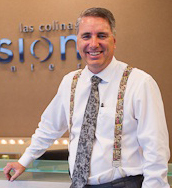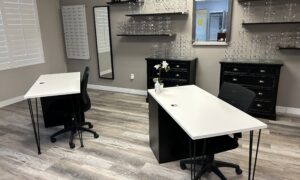By Ken Krivacic, OD, MBA

April 15, 2015
SYNOPSIS
Improving quality and patient satisfaction—and not just cutting costs–is the best route to practice profitability. Three key areas to upgrade: new instrumentation, one-day CLs, better office flow.
ACTION POINTS
INVEST IN NEW INSTRUMENTATION. New instruments can provide patients with a memorable, wow experience.
PROMOTE PREMIUM CONTACT LENSES. The product is more costly to patients, but you send a message that quality is more valuable than price.
ENHANCE PATIENT FLOW. A third-party evaluation of office flow can be costly, but may allow you to add more patients per day and improve the patient experience.
Cutting costs and capturing efficiencies often is seen as the fast route to profitability. While those factors matter, in an optometric practice, as in any business, the best route to sustained profitability requires investing in your practice to improve the level of care and service you provide, and elevate patient satisfaction.
In addition to improving the patient experience, following the principle of “Better Before Cheaper” has added $175,000 in annual revenues to our practice.
This article is based on the rule, “Better Before Cheaper,” highlighted in the book, Three Rules: How Exceptional Companies Think, by Micheal Raynor and Mumtaz Ahmed.
These authors set out to discover how some companies survive and thrive while others fade away and die. They analyzed 45 years of data on nearly 25,000 companies for their research, and used data from 1966 to 2010 to determine why some companies grow and others go out of business. They discovered three rules of management that differentiated profitable from less profitable companies.
I recently showed, in the ROB article, Three Rules to Make Your Practice Greater, how I have applied the concepts in this book to my own practice. —Ken Krivacic, OD, MBA
New Instrumentation: Deliver “Wow” Experience
A few years ago, we decided to upgrade our phoropters to the newer auto-phoropters that are available. Are these phoropters better than the standard phoropters that have been available for decades? Most ODs would probably say they don’t necessarily allow you to perform a better refraction. I would agree and say that my prescriptions are no better now than before we had the auto-phoropters.
But ask our patients if they are getting a better eye exam, and the answer would be a resounding, “Yes.” Notice thatI said “eye exam,” and not refraction. Most patients lump the two together, so by association, they feel like they’ve had a better exam. Do the auto-phoropters help the bottom line? I don’t have numbers to back that up, other than to say our optical revenue continues to grow at a steady pace.
Whenever an OD buys anything, there are two dimensions to the value we get from our purchase: price and non-price. Price is relatively simple: it’s the value we get from the purchase relative to how much we paid for it. Non-price is the value of the purchase relative to all the other dimensions that are not price: durability, functionality, quality, convenience, style, brand, etc. I would argue the auto-phoropter falls into the non-price value, and aids in the purchase of eyeglasses from our office.
Read More About
Business Success Differentiators
For more information about the article “Three Rules for Making a Company Truly Great, visit www.thethreerules.com. The authors have also followed up on the article with a book The Three Rules: How Exceptional Companies Think. Other books you may find helpful on this subject: Thomas Peters and Robert Waterman’s In Search of Excellence and Jim Collins’s Good to Great. —Ken Krivacic, OD, MBA
Contact Lenses: Promote One-Day CLs
My practice prescribes and sells a large quantity of contact lenses. A philosophy we have adapted over the past several years is to promote the single-use, or one-day, modality of contact lenses. We do this for several reasons: health, convenience and reduction of complications. I feel generally that single-use lenses are better than all other modalities. Are they the cheapest? No way. So, in a way, we have applied the Better before Cheaper rule to our contact lens patients.
We present the single-use modality first and promote it as the best. As with any purchase, price factors into the equation when patients make a purchase. If the price of single-use is above what patients will pay–or what they value–then we move down the list to the other modalities of two-week or monthly.
You should promote the better product in all sales, yet keep in mind that price plays a part. If you start with Cheaper, then you are sending a message to your patients that you value price over the other benefits that contact lenses offer: health, convenience and reduction of complications. You are creating a value to your patients, and it is much easier to compete in non-price values than in price-only values.
Smoother Patient Flow
Several years ago, we made the decision to improve the patient flow in our clinic. We hired a consulting agency, and after evaluation, brainstorming, strategy and implementation, we ended up smoothing the flow of patients through the office, and even increased the number of exams we saw per day to two extra without feeling rushed.
We received feedback from patients that they at times felt rushed and had to be moved from room to room, much more than they felt was necessary. It was this feedback that motivated us to hire a consulting firm to help us out. Could we have tackled the problem on our own? Probably. Would the results have been as positive? Probably not. Would it have been cheaper? Yes, by a long shot. The consulting fee was close to $15,000. Why was this better? From the non-price perspective, it smoothed the flow of patients through the office, which resulted in a better experience for patient, staff and doctor. The complaints from patients of feeling rushed were reduced dramatically.
From the price perspective, the change in schedule resulted in adding two extra patients to our schedules per day. Since we have two full-time doctors, the extra exam slots resulted in 500 additional patients per year. Our average revenue per patient is just over $350. The extra patients added additional revenue of close to $175,000 per year. Not bad for what looked like a large investment to begin with. Also keep in mind that $175,000 is only what we gained after one year following the office flow improvements. Multiply that increase in revenue over several years and the rule Better before Cheaper looks better all the time.
In the next article in this series, I will discuss how we can apply Rule #2: Revenue before Cost in managing a profitable optometric practice.
Ken Krivacic, OD, is the owner of Las Colinas Vision Center in Irving, Texas. To contact him: kkrivacic@aol.com.

























